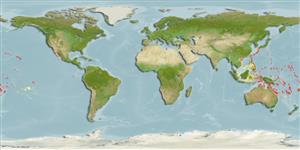>
Anguilliformes (Eels and morays) >
Muraenidae (Moray eels) > Uropterygiinae
Etymology: Uropterygius: Greek, oura = tail + Greek pterygion = little wing. Fin (Ref. 45335); xenodontus: Specific name from the Greek 'xenikos' meaning strange and 'odontos' meaning tooth..
More on authors: McCosker & Smith.
Environment: milieu / climate zone / depth range / distribution range
Ekologi
marina revassocierade; djupintervall 6 - 9 m (Ref. 27479). Tropical
Pacific Ocean: Coral Sea, American Samoa, the Marshall Islands, and Johnston Islands.
Size / Vikt / Age
Maturity: Lm ? range ? - ? cm
Max length : 53.0 cm TL hane/ej könsbestämd; (Ref. 37816)
Short description
Morfologi | Morfometri
Ryggkotor: 154 - 157. Body uniformly gray-brown; laterally compressed, subrectangular in cross-section. Vertical fins restricted to the tail tip; anus at mid-body; one branchial pore (Ref. 27479).
Inhabits corals and crevices of shallow lagoon and seaward reefs (Ref. 37816). Benthic (Ref. 58302).
Life cycle and mating behavior
Könsmognad | Reproduktion | Lek | Ägg | Fecundity | Larver
McCosker, J.E. and D.G. Smith, 1997. Two new Indo-Pacific morays of the genus Uropterygius (Anguilliformes: Muraenidae). Bull. Mar. Sci. 60(3):1005-1014. (Ref. 27479)
IUCN Red List Status (Ref. 130435)
Threat to humans
Harmless
Human uses
Ytterligare information
PopulärnamnsynonymerMetabolikPredatorerEkotoxikologiReproduktionKönsmognadLekSpawning aggregationFecundityÄggEgg development
Age/SizeTillväxtLength-weightLength-lengthLength-frequenciesMorfometriMorfologiLarverLarvdynamikRekryteringAbundansBRUVS
referenserVattenbrukVattenbruksprofilAvelslinjerGenetikElectrophoresesÄrftlighetSjukdomarBehandlingNutrientsMass conversion
MedarbetareBilderStamps, Coins Misc.LjudCiguateraHastighetSimsättGälytaOtolithsHjärnstorlekSyn
Verktyg
Special reports
Download XML
Internet-källor
Estimates based on models
Preferred temperature (Ref.
123201): 24.8 - 29.4, mean 28.1 °C (based on 1041 cells).
Phylogenetic diversity index (Ref.
82804): PD
50 = 0.5000 [Uniqueness, from 0.5 = low to 2.0 = high].
Bayesian length-weight: a=0.00069 (0.00033 - 0.00144), b=3.12 (2.93 - 3.31), in cm total length, based on LWR estimates for this (Sub)family-body shape (Ref.
93245).
Trofisk nivå (Ref.
69278): 3.5 ±0.6 se; based on size and trophs of closest relatives
Resiliens (Ref.
120179): Mellan, lägsta populationsfördubblingstid 1,4-4,4 år (Preliminary K or Fecundity.).
Fishing Vulnerability (Ref.
59153): Moderate vulnerability (41 of 100).
